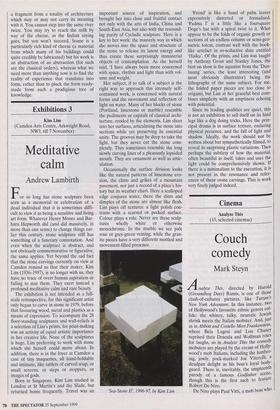Exhibitions 3
Kim Lim (Camden Arts Centre, Arkwright Road, NW3, till 7 November)
Meditative calm
For so long has stone sculpture been seen as a memorial or celebration of a dead individual that it is sometimes diffi- cult to view it as being a sensitive and living art form. Whatever Henry Moore and Bar- bara Hepworth did (and did massively, in more than one sense) to change things ear- lier this century, stone sculpture still has something of a funerary connotation. And even when the sculpture is abstract, and not obviously commemorative or figurative, the same applies. Yet beyond the sad fact that the stone carvings currently on view at Camden remind us that their maker, Kim Lim (1936-1997), is no longer with us, they have no trace of overt human aspiration or failing to mar them. They exert instead a profound meditative calm and rare beauty.
The exhibition is not intended as a full- scale retrospective, for this significant artist only began to carve in stone in 1979, before that favouring wood, metal and plastics as a means of expression. To accompany the 28 floor-standing sculptures and wall-reliefs is a selection of Lim's prints, for print-making was an activity of equal artistic importance in her creative life. None of the sculptures is huge, Lim preferring to work with stone which she herself could move about. In addition, there is in the foyer at Camden a case of tiny maquettes, all hand-holdable and intimate, like tablets of carved soap, or small screens, or steps or stoppers, or images of gods.
Born in Singapore, Kim Lim studied in London at St Martin's and the Slade, but returned home frequently. Travel was an
Andrew Lambirth
important source of inspiration, and brought her into close and fruitful contact not only with the arts of India, China and South-East Asia, but also with the resound- ing purity of Cycladic sculpture. Here is a key to her work: the masterly way in which she moves into the space and structure of the stone to release its latent energy and thus create these surprisingly immaterial objects of contemplation. As she herself said, 'I have always been more concerned with space, rhythm and light than with vol- ume and weight.'
Her subject, if to talk of a subject is the right way to approach this intensely self- contained work, is concerned with natural forms and the movement and reflection of light on water. Many of her blocks of stone (Portland, limestone or marble) resemble the pediments or capitals of classical archi- tecture, eroded by the elements. Urn slices into her surfaces, articulating the stone into sections while yet preserving its essential unity. The grooves may be deep to take the light, but they never cut the stone com- pletely. They sometimes resemble the long slowly curving lines of a pleasantly lopsided mouth. They are ornament as well as artic- ulation.
Occasionally the surface division looks like the natural patterns of limestone ero- sion, the clints and grikes of a mountain pavement, not just a record of a place's his- tory but its weather chart. Here a scalloped edge conjures water, there the dints and dimples of the stone are almost like flesh. Lim plays off textures: a light polish con- trasts with a scarred or pecked surface. Colour plays a role. Never are these sculp- tures wholly white or otherwise monochrome. In the marble we see pale rose or grey-green veining, while the gran- ite pieces have a very different mottled and movement-filled presence.
`Sea-Stone II, 1996-9Z by Kim Lim `Frond' is like a hand of palm leaves expressively distorted or formalised, Padma I' is a little like a foursquare Doge's hat with a spiral twist to it. What appear to be the folds of organic growth or sections of an endless column or semi-geo- metric totem, contrast well with the book- like artefact in so-seductive slate entitled `Haiku'. Of the prints, and Lim was taught by Anthony Gross and Stanley Jones, the best on show is the aquatint from the `Dun- huang' series, the least interesting (and most obviously illustrative) being the lithographs of the same subject. For me, the folded paper pieces are too close to origami, but Lim at her graceful best com- bines simplicity with an emptiness echoing with potential.
Since its leading qualities are quiet, this is not an exhibition to sell itself on its hind legs like a dog doing tricks. Here the prin- cipal drama is in surface texture, enduring physical presence, and the fall of light and shadow. Ideally, the work should not be written about but sympathetically filmed, to reveal its surprising plastic variations. Then perhaps the subtlety of how the material, often beautiful in itself, takes and uses the light could be comprehensively shown. If there is a minimalism to the execution, it is not present in the resonance and refer- ences of these stone carvings. This is work very finely judged indeed.


























































































 Previous page
Previous page